By the time we reach adulthood and come face to face with the full responsibilities of life, we’ve already been through years of training around managing our time. From experiences in early education through to high school and college, time-strict schedules have marked the path for us.
But what if managing your time wasn’t the best way to perform well at work and show up in the way that you would like to in your personal life?
The authors of the book The Power of Full Engagement, Jim Loehr and Tony Schwartz, argue that it’s actually energy, not time, that’s the fundamental currency of high performance.
I’d like to explore (in words and sketches) some of the key ideas from that book because I’ve found them to be incredibly impactful. They’ve shifted the way that I approach my life and the decisions that I make each day.
Energy Management vs Time Management
One of the first things they point out about time compared to energy is that time is a fixed quantity – there’s only so much of it every day. Energy, on the other hand, is not fixed. The amount of energy that you have during any specific period of time is dependent on a variety of conditions, and the overall argument of this book is that it’s worth it to pay more attention to your energy than it is to pay attention to time.
The focus on time comes from a machine-centered way of viewing the world and of viewing the human experience in it. That machine-centered approach is all about the optimization of technology and equipment. But we humans are not machines, and thinking of ourselves as one isn’t that helpful.
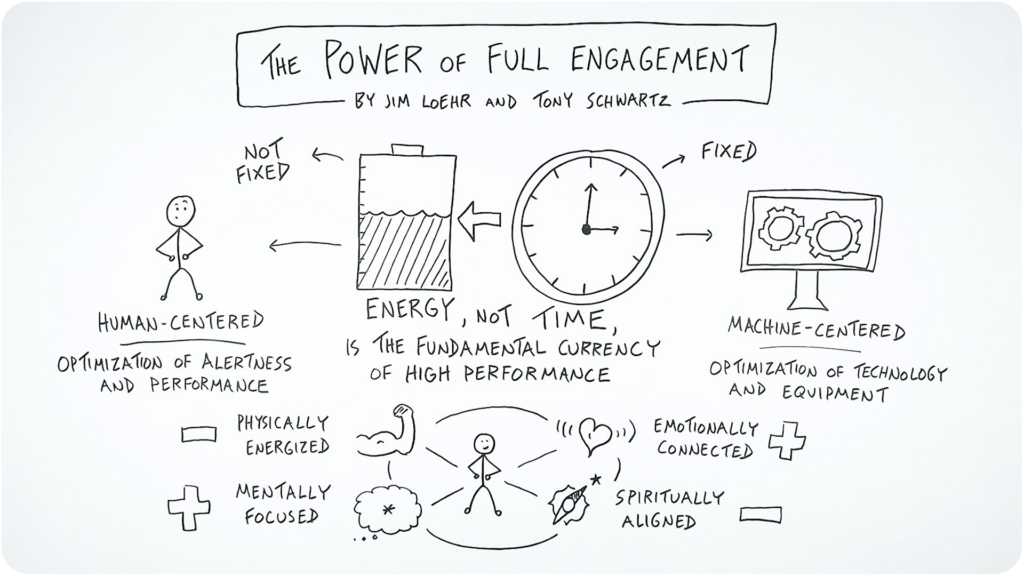
The focus on energy, on the other hand, comes from a human-centered point of view. Here the goal is the optimization of alertness and performance. What’s important isn’t the amount of time that you devote to any particular task, it’s the quality of the energy that you bring to it. Even just 20 minutes of high-quality energy will do a ton more good than an hour or two of low-quality energy spent on that task.
The machine-centered approach reminds me of some ideas that I read about in Cal Newport’s book Digital Minimalism, which I explore in depth here. In that book Newport contrasts digital minimalism to digital maximalism, where the idea is to adopt any new technology that provides even the smallest benefit, disregarding the potentially huge cost that might come along with the adoption of that technology.
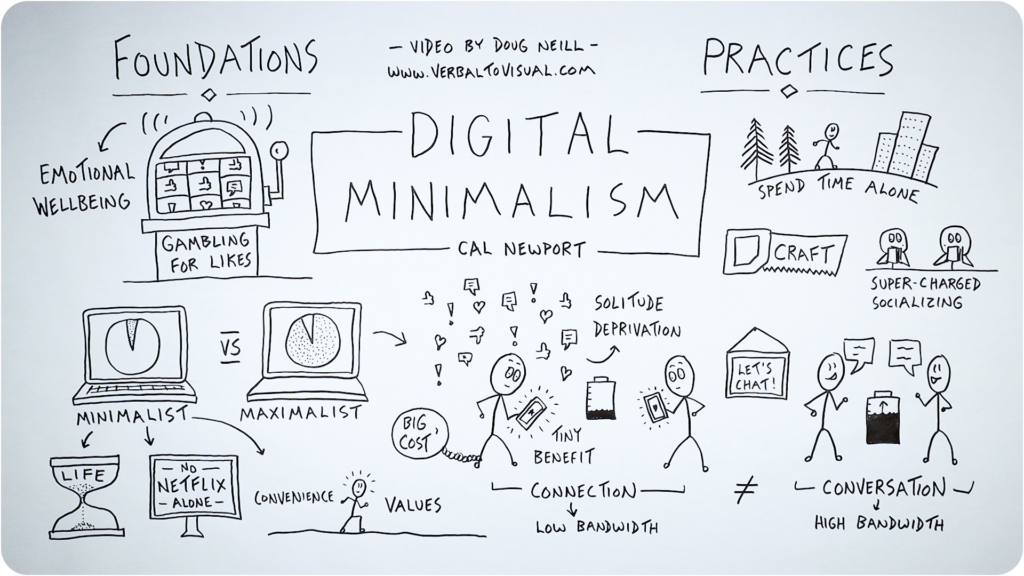
The digital maximalist (or machine-centered) approach has the potential to lead us astray from what’s actually the most helpful for us. Searching for the best productivity app might take you in the wrong direction. So rather than seeking out that external technological tool, better to turn inward and pay more attention to the energy that you’re bringing to the work in front of you.
The goal of this book, then, is to help us bring our best energy to the various projects we spend our time on each day.
What I found to be useful were the four categories of energy that the authors choose to focus on. The first is physical energy, with the ideal state being physically energized. Then there’s emotional energy, with the goal of feeling emotionally connected. Then we’ve got mental energy, with the ideal state being mentally focused. And last but not least, spiritual energy, with the ideal state attained when our actions are in alignment with our deepest values.
These different categories of energy aren’t independent of each other, but the authors point out that generally we tend to be overtrained and overextended in the realms of mental energy and emotional energy. We expend so much energy in those two categories each day (often in the service of getting more done quicker), and we tend to neglect our physical energy and our spiritual energy.
The authors devote a full chapter to each of those four types of energy, which I’ll explore later in this article.
First, though, a deep dive on how the authors think about energy in general.
Energy Oscillation
There’s one main idea that the authors hammer home time and time again throughout this book: the importance of cycling between expending energy and then giving yourself time to recover energy before you go expend more of it. That cycle is what we as human beings need in order to continue performing well.
They point out that if you manage that cycle well, you can actually expand your capacity in any one of those four categories of energy. That’s like increasing the size of your battery. To do that, first you have to expend energy past your current limits. Then, equally important, you must give yourself the opportunity to recover. Without that recovery period your battery doesn’t grow, you just burn out.
On the flip side, if you don’t expend energy within one of those given categories, your battery will contract. Your tank of physical energy or spiritual energy (the two most often neglected) will be smaller because of its lack of use.
What I find helpful about this overall framework is that it encourages you to maintain a balance of expending energy and recovering energy across those four categories – that’s what will lead to a fully engaged life, which is one of the ways I define success.
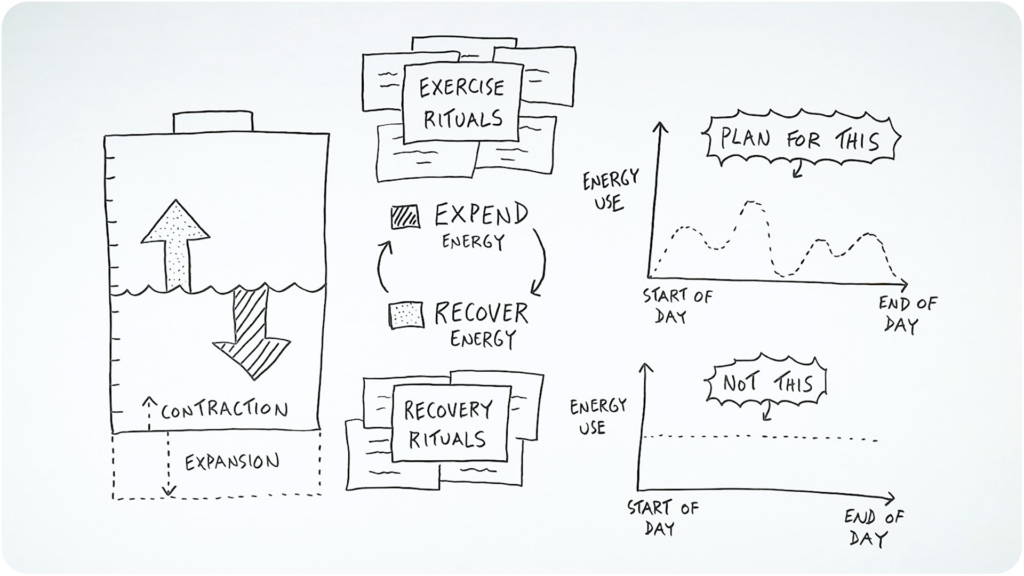
They encourage you to think about your energy use throughout the day as oscillating, with peaks and valleys – times when you’re working hard in a given area, other times when you’re resting.
That oscillation stands in pretty stark contrast to a linear view of energy expenditure, which is often at the core of productivity or time management systems. Those tend to begin with the assumption that within every single block of 30 minutes from 8 am to 5 pm you’ll be able to bring the same amount of energy to the task in front of you.
That’s just not how humans work.
So as you think about and plan out your days, you should plan for an oscillation of energy, not for a steady state of it.
It’s with the idea of planning for that oscillation that rituals come in. Some rituals focus on the expenditure of energy, others on the recovery side. It’s the balance of those two types of rituals throughout your day that will help you maximize the quality of the energy and attention that you’re able to bring to each task and each interaction throughout the day.
Within the book you’ll read about many examples of rituals from real people that the authors worked with. You’ll hear about the specific challenges that they had and the rituals that they built into their days to address those challenges and balance things out, adding some exercise in the categories that were lacking, some recovery in those that were overextended.
Throughout the rest of this article I’ll be sharing some of my rituals as we look at each category of energy, starting with physical.
Physical Energy
The authors describe your physical energy as the most fundamental of the four. If you’re lacking in physical energy, it’s pretty hard to bring high-quality emotional, mental, or spiritual energy to whatever’s in front of you.
Here I’ll highlight five components of your physical health that are worth paying attention to, starting with the breath. This is probably the simplest and most accessible lever of physical energy that can be accessed through deep breathing, taking a deep breath in to a count of three and then a slow breath out to a count of six.
It’s sometimes surprising how easy it is for us to get stuck in shallow breathing because of the stresses we encounter throughout the day. But taking the time to slow down and go through a few cycles of deep breathing is one of those small but impactful recovery activities that, when done regularly throughout the day, adds up to a big impact. It provides a bit of physical recovery as well as emotional recovery.
But of course deep breathing alone won’t bring you all the physical energy you need – food is pretty darn important too. The approach that the authors suggest here is to eat the three standard meals of breakfast, lunch, and dinner, but never overdo it during those meals. Instead, stick to a reasonable portion size and then have a snack in between each meal so that you replenish that source of energy every three hours or so.
This is where can see the theme of oscillation in practice, with the goal of sustained energy throughout the day. You never let yourself get too hungry, but you also never get too full. Those three-hour cycles, plus the tip of drinking lots of water throughout the day, will give your body what it needs from a nutritional standpoint. In the book they dive deeper into the specific types of foods that they encourage, in case you want to check that out.
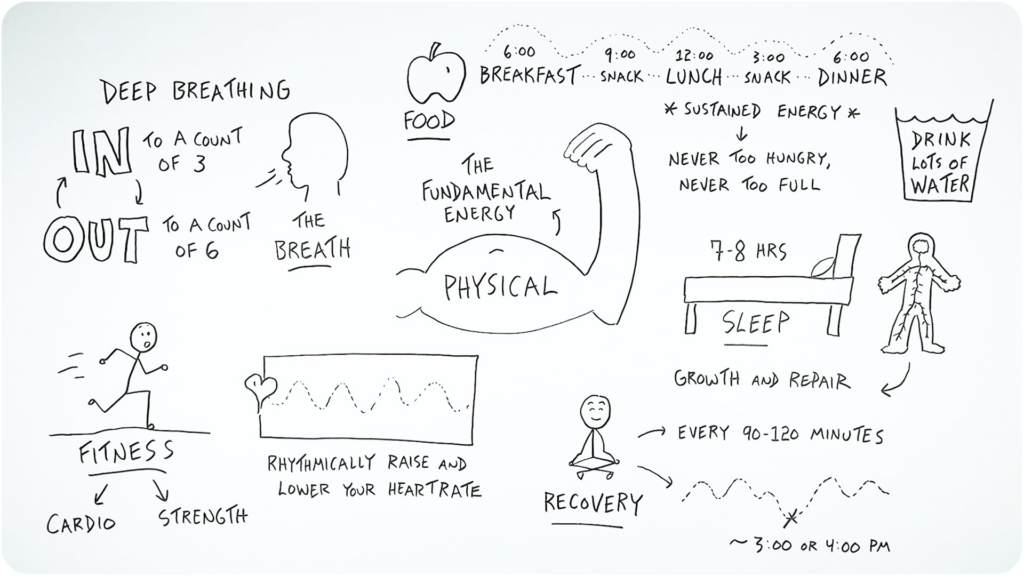
Then we get to the piece of advice that you might be tired (literally) of hearing: get enough sleep. It’s the importance of those seven to eight hours every night. Though that might be familiar, I feel like the reminder never hurts, especially considering that it’s during sleep that growth and repair occurs throughout your body, within your brain but also across your whole system, keeping you healthy and working the way it should.
With sleep filling that recovery part of the energy cycle, spending time on your physical fitness gets at the exercise part. The authors talk about the benefits both of cardio work and strength training, with the goal being to rhythmically raise and lower your heart rate, and how good that is for both your body and your brain.
In addition to sleep being the way you recover at night, it’s also worth pointing out the importance of recovery throughout the day, specifically needed every 90 to 120 minutes. The authors point out that in addition to circadian rhythms that occur every 24 hours, there are also ultradian cycles that occur throughout the day. When you look at the combination of circadian rhythms and ultradian rhythms, the lowest point overall is around 3 or 4 pm in the afternoon. For me it’s really helpful to know that that has a biological cause, and that it might not be the best idea to fight that dip with caffeine or self-imposed pressure to get more work done. Better instead to fill that time with a recovery activity.
Here are a few of my own rituals in the realm of physical energy.
I’ve settled into a three-part exercise routine that I really enjoy. I’ll go for a run on one day, do some yoga the next, and then some strength training the day after that, and then start the cycle over again. I like that variety each day – never doing the same type of exercise two days in a row. I think it hits at a nice overall balance of some cardio, some strength, and some flexibility.
I also find that this exercise routine hits on all four categories of energy. It is of course a physical experience, but it also leads to emotional recovery. When I’m out on a run I feel a boost in mental energy, with insights often arising without having to work at it. Both yoga and running outside have a spiritual component to them that I enjoy.
The second, newer, physical ritual that I started after reading this book is a deep breathing practice. I try to kickstart that when I first enter my home office after breakfast, with a handful of cycles before I start my work. I find that having a dedicated time in the morning for some deep breathing makes it more likely that I’ll remember to do it throughout the day. I try to bring that practice in again when I’m transitioning from one mode of work to another.
Speaking of transitions, let’s move next to emotional energy.
Emotional Energy
With this as well as the next two types of energy, the authors identify the metaphorical muscles that are worth exercising. That aligns with the general theme of athletics that’s part of the background of these researchers, and where they first identified the importance of small but impactful recovery systems. As someone who played a lot of sports growing up and continues to enjoy physical activity, those references to athletic performance and how they can tie directly to other forms of performance really resonated with me.
For emotional energy, the muscles they identified are self-confidence, self-control, social skills, and empathy.
What I’d like to highlight from this chapter are first the things that tend to expend your emotional energy, and then some activities to help you recover that energy.
On the expenditure side, it tends to be negative emotions that draw down your energy levels – emotions like fear and frustration, anger and sadness. The author’s pointing out that those negative emotions aren’t bad. In fact, they play an important role in life: they direct us toward something that needs addressing. With that said, experiencing too much of those negative emotions releases stress hormones that can become toxic in your body.
So the approach here is not to ignore those negative emotions, but instead to acknowledge them, and then instead of sitting within them for long periods of time, try to move toward a recovery activity that helps bring you back to a neutral if not positive state, where you’re more likely to be able to address what caused that negative emotion in the first place.
This is where the refueling activities come in.
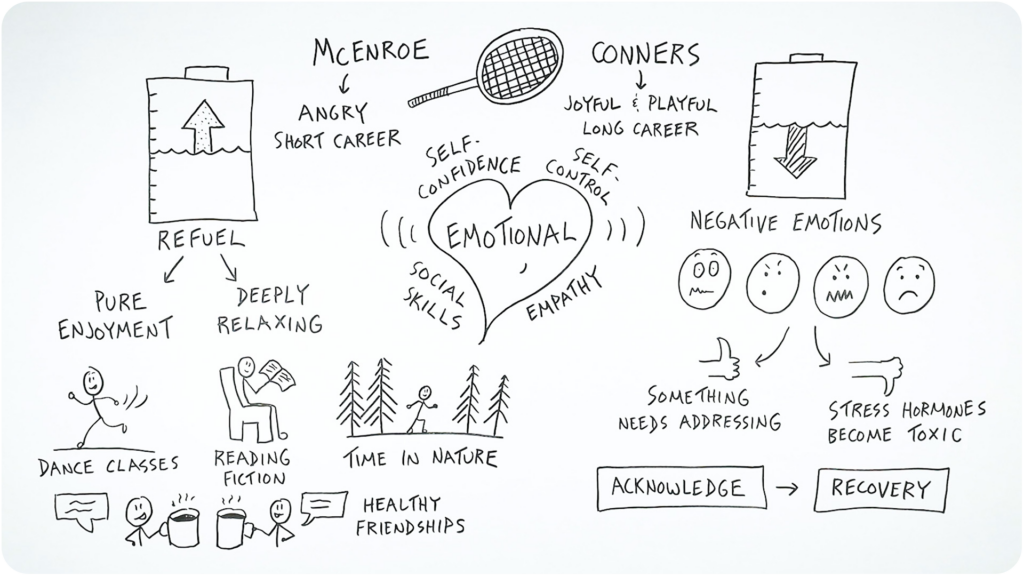
To refill your emotional energy tank, the authors encourage you to seek out activities for pure enjoyment or that are deeply relaxing.
One example they share is a person who signed up for dance classes after work a couple days a week, and the joy that that brought into her life (not to mention the physical benefits as well). Reading fiction was another example that fits more into the deeply relaxing category. Time spent in nature gets at both, as does grabbing a cup of coffee with a good friend and having a nice chat.
Some of those activities make me think once again of Digital Minimalism and what Newport calls high-quality leisure, how those are the types of activities that you might bring into your life after ramping down on the amount of digital media that you consume.
In this chapter the authors bring in an example from the world of professional athletics, tennis specifically, as they compare and contrast the careers of John McEnroe and Jimmy Connors.
The heyday of those two athletes was a bit before my time, but even so I was familiar with McEnroe because of his reputation for getting angry and frustrated, throwing rackets, and yelling at the refs. Connors, on the other hand, I hadn’t heard of.
While both of those athletes were very successful, the important distinction is that McEnroe had an angry short career, whereas Connors had a joyful and playful long career. That highlights how leaning too far into those negative emotions, even if you feel like they are fueling you, is unsustainable. Better to approach that sport, that career, that family life in a joyful and playful manner instead.
One of my emotional energy routines arose after reading Digital Minimalism, when I chose to dramatically cut down on digital media consumption. I chose to not watch Netflix alone, not visit Twitter or Facebook or Instagram at all, and I even cut back on my podcast listening.
I shifted my media consumption almost exclusively to physical books, both fiction and nonfiction. I start and end my day reading a novel. I enjoy that both as a nice way to wake up and then as a calming activity to help me wind down. Throughout the day, in between work tasks or family commitments, I’ve got a couple of non-fiction books that I’m reading.
As I think about my life over the past few months since I made that shift in the type of media that I consume, I think it’s within this category of emotional energy that I’ve seen the biggest impact. My overall energy levels are a lot higher and a lot more positive than they were when social media was a big part of my life, or when I was watching a lot of Netflix on my own.
As I mentioned in the previous section, my exercise routine has a large impact on my emotional energy levels as well, where I’m expending physical energy but refueling my emotional energy.
Let’s move next to the third category of mental energy.
Mental Energy
To increase the capacity of your mental energy, the authors encourage you to focus on the muscles of mental preparation, positive self-talk, creativity, effective time management, and visualization.
It’s worth pointing out the paradox of time management showing up here. Even though this book as a whole is about energy management, time management is still a useful skill. But it’s lower in the hierarchy. Yes, it’s useful and it has its place, but it’s secondary to energy management.
Within this chapter the authors identify a set of performance enhancers related to the use of mental energy, such as the value of sustained concentration, as opposed to bouncing too quickly from one task to the next, or trying to do multiple tasks at once. Here I’m reminded again of Cal Newport’s work, this time the book Deep Work, which I found to be helpful in shaping my approach to the creative work that I do.
Another performance enhancer is moving from broad to narrow, thinking about the topic in front of you from a broad, zoomed out perspective, and then zooming back in to take the narrow view. Experiencing things from both of those perspectives can enhance the quality of your mental work.
A similar cycle is a back and forth between an internal focus – what’s going on inside of you, how the ideas are applied to your life, and an external focus – how what you’re working on applies to other people.
The fourth performance enhancer is realistic optimism. It’s not about head in the clouds or head in the sand, it’s about keeping your eyes open, seeing the world as it is, and always working positively toward a desired outcome or solution. Maintaining that sense of realistic optimism will help you do better work, without getting distracted by fantasies or bogged down by frustration and self-doubt.
The authors also share how powerful it can be to intermittently change mental channels. This concept had one of the most dramatic impacts on how I think about my day, and how I choose the sequence of activities that I might take on.
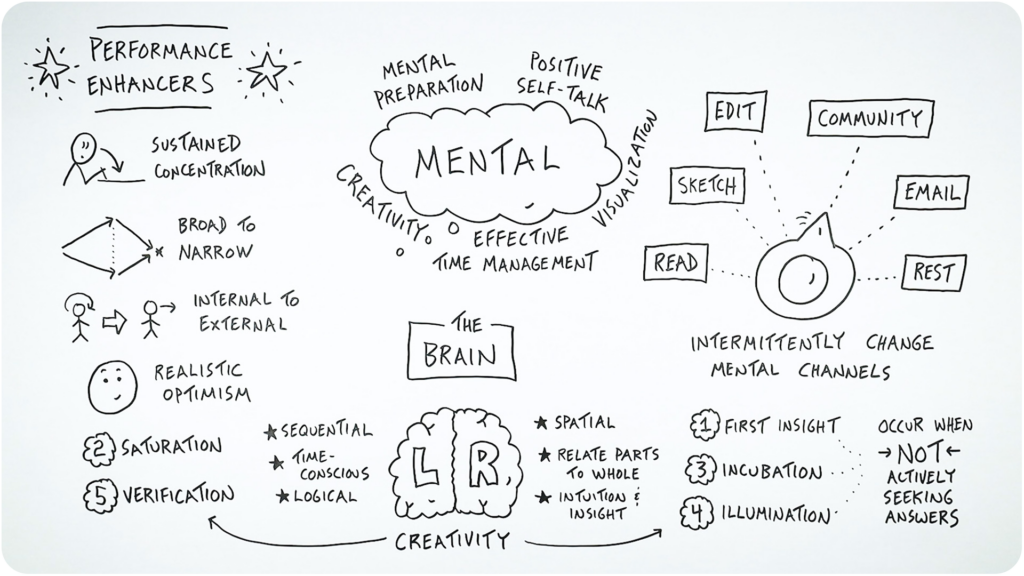
For example, I mentioned starting my day with fiction but then reading plenty of nonfiction throughout the day. I can bounce from that type of activity to sketching out some of the ideas that I’m reading about. Then maybe I move over to editing a video, for example. From there maybe I’ll shift over from those internal activities to an external one and engage with the community members inside of Verbal to Visual, the online learning platform that I host where I teach the skill of sketchnoting.
Then maybe I’ll hop back to some editing or reading, then maybe hop over to email for some one-on-one interactions and to clear that particular inbox, then maybe back to some sketching or switching over to some rest.
I feel lucky to have the flexibility in my schedule to decide what type of activity to spend the next 30 minutes or an hour on, then step back, take a deep breath or two, and think about what mental channel would feel the most refreshing to switch to next.
I also think this idea of switching modes applies well to the four different categories of energy. Instead of just switching between mental channels, sometimes I recognize I need a break from mental work entirely and would benefit from expending some physical energy.
Within this chapter on mental energy, the authors also do a deep dive into the brain and how creativity works. They talk about the differences between what’s going on in the left side of the brain versus the right side of the brain.
The left side is where sequential, time conscious, and logical thinking occurs. The right side is where spatial thinking, relating parts to the whole, and intuition crop up.
They define creativity as a five-step process that involves a bouncing back and forth between the right and left hemispheres of the brain. It starts on the right side with a first insight – the initial spark of a new idea. Then you hop the left side for saturation, which is more of a research stage, intentionally exploring whatever was at the core of that insight. Then you hop back to the right side for an incubation period where you’re mulling over those ideas. The next step of illumination is also on the right side. That’s where a breakthrough occurs, something that helps you bring all of those ideas together or recognize the most important nugget of whatever it is you’ve been thinking about. Finally, it’s back to the left side for verification, where you think more logically through what you came up with, to confirm how valid or not it is.
Those activities that occur in the right hemisphere happen when not actively seeking answers, which highlights the importance of changing mental channels throughout your day, while also making sure to engage in those activities that are purely about recovery, or that focus on expending energy in one of the other three categories. For example, going for a run provides a great time to let my mind wander, and that’s where the creative steps of first insight, incubation, and illumination often occur.
Let’s now move to the fourth and final category of energy – spiritual.
Spiritual Energy
The topic of spiritual energy was the one that I was the most curious about, because I wanted to know how they defined it and what type of activities would fall into the exercise or recovery categories.
The definition resonated with me more than I thought it might, which focuses on alignment between your actions and your deepest values. The metaphorical muscles here are character, passion, integrity, honesty, and commitment, where spirituality is about the connection to a deeply held set of values and to a purpose beyond our own self-interest.
It’s this category of energy that’s probably the easiest to overlook. But taking the time to identify your deepest values and to identify a purpose that exists beyond your own self-interest, that in itself becomes an energy source that feeds into all of the others and will support the particular actions that you take each day.
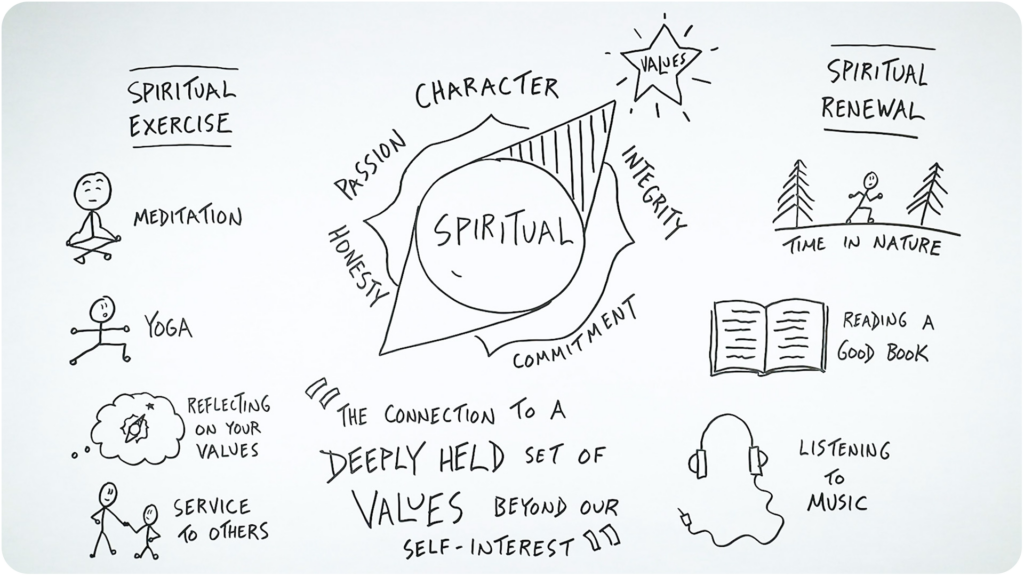
You can exercise your spiritual energy through activities such as meditation, yoga, setting aside time to reflect on your values, or being of service to others. On the renewal side we see once again time spent in nature (which also showed up when exploring emotional energy), or just reading a good book, especially one that explores what it means to live a good life, whether that’s non-fiction or fiction. Listening to music is another spiritual activity that can provide renewal.
When I think about identifying a deeply held set of values and a purpose beyond my own self-interest, I think about parenthood. I’m the father of twin boys who just turned one year old, and three days a week I’m on child care duty during the full work day, which has led to a significant shift in where I spend my energy.
One challenging aspect of new parenthood is how much I enjoy the work that I do, and how easy it was early on to try to cram too much into a single day, with too much multitasking. Yes, I’d watch after the boys, but maybe I’d also try to get a few emails out or a little bit of editing done.
Eventually the practice that I found to be the most helpful was switching mentally into weekend mode after the boy’s first nap. By that time I’ve already had two solid work sessions: one early morning before the kids wake up, and another during their first nap. Once they wake up, that’s when I try to make a mental shift of leaving work behind and giving my full attention to the boys, and perhaps some basic maintenance tasks around the house.
It helps to think of it as a weekend, not just that it’s the end of my work day. There’s something about imagining it as Saturday that takes the pressure off of myself to get more work done, and because of that I found that I enjoy my days overall a lot more. I’m more efficient with those dedicated work sessions, and the quality of my time and attention with the boys is higher.
Another ritual that my wife and I have added into our weekly routine is a Sunday night chat, after the boys are in bed, which is a space for us to have deeper conversations that aren’t just around scheduling the next day’s events.
That’s a regular opportunity for us to reflect on our values while also addressing bigger questions or challenges that are easy to neglect and push off in the face of all of the day-to-day things that can occupy our attention.
So at this stage of life, my connection to spiritual energy comes from a focus on family. While there are plenty of family and child care tasks that are quite physically and emotionally draining, there’s a whole lot of spiritual renewal that comes along with my interactions with the boys and seeing them grow.
The Big Picture
As you have probably seen, there’s a comprehensiveness to those four categories of energy that I really appreciate, as well as a simplicity to the overall approach of energy expenditure and energy recovery.
That’s why I wanted to spend so much time here sharing these ideas with you, because sharing them in this way helps to solidify them in my own mind and apply them in my own life.
That’s actually what first pulled me into the world of visual note-taking. A common experience for me was to read a book and enjoy it, be able to talk about it and maybe apply the ideas while reading and perhaps for a few weeks or months after, but how quickly those ideas faded into the background.
But then I started engaging with those ideas on a deeper level, primarily by sketching them out, identifying the overall framework and then illustrating some of the specific examples. I’ve come to really value and appreciate that way of interacting with a book or any other information source.
If that’s a skill that you would like to develop as well, in order to create your own visual summaries of the books you’re reading or classes you’re attending or podcasts you’re listening to, then come join us inside of Verbal to Visual.
That’s where I teach this skill. That’s where you’ll find a full library of complete-at-your-own-pace online courses, as well as a global community of visual thinkers who are sharing their work as they engage with the ideas that are the most important to them.
I hope that you have enjoyed this exploration of The Power of Full Engagement. If so, I encourage you to pick up the book, learn from all of the other examples that are shared, as well as all of the other details that I didn’t have time to mention here.
Thanks for spending your time and attention with me. I wish you luck deciding what to do with your energy next.
And I look forward to sharing more ideas with you next time.
Till then,
-Doug






